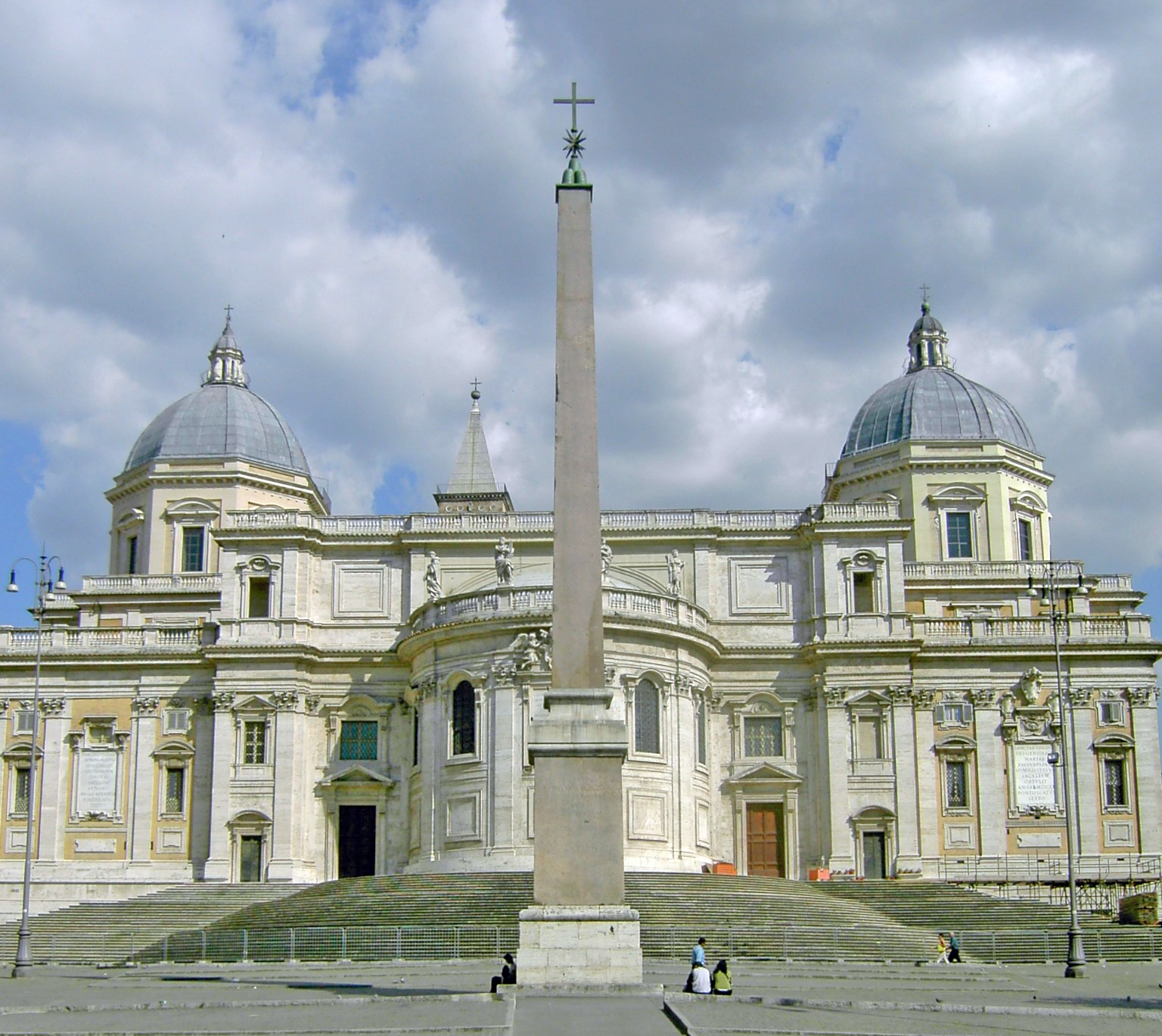|
Carlo Rainaldi
Carlo Rainaldi (4 May 1611 – 8 February 1691) was an Italian architect of the Baroque period. Biography Born in Rome, Rainaldi was one of the leading architects of 17th century Rome, known for a certain grandeur in his designs. He worked at first with his father, Girolamo Rainaldi, a late Mannerist architect in Rome. After his father's death, he fully embraced the monumental Baroque style. He gained ascendancy in Rome when the Barberini pontificate of Pope Urban VIII was replaced by that of the more austere Pamphilj papacy of Innocent X. His works include the façade of Sant'Andrea della Valle (1661–1665), the façade of San Girolamo della Carità (1657}, the twin churches of Santa Maria dei Miracoli and Santa Maria in Montesanto, and Santa Maria in Campitelli (1663–1667). He was unable to complete the facade of Sant'Agnese in Agone during work in 1653–1657. The high altar of Santa Maria della Scala is by Rainaldi. Beyond his work as an architect in stone, Rainaldi ... [...More Info...] [...Related Items...] OR: [Wikipedia] [Google] [Baidu] |
Santa Maria In Campitelli
Santa Maria in Campitelli or Santa Maria in Portico (''Santa Maria in Portico di Campitelli'') is a church dedicated to the Virgin Mary on the narrow Piazza di Campitelli in Rione Sant'Angelo, Rome, Italy. The church is served by the Clerics Regular of the Mother of God. History Tradition holds that a primitive oratory or church was founded at the site during the years 523–526, under the papacy of Pope John I. This structure was located near the Porticus Octaviae (giving the church and icon its name of "Madonna of the Portico"). The structure was created to house a venerated 25 cm-high icon of the Virgin Mary and Saints Peter and Paul. According to legend, the icon appeared miraculously in 524 at the table of Galla, a Roman woman who was helping the poor, and it was said to be carried in processions since 590. The initial church structure was the no-longer extant Oratory of Santa Galla, located across the piazza from the present church, and which was attached to a hosp ... [...More Info...] [...Related Items...] OR: [Wikipedia] [Google] [Baidu] |
1691 Deaths
Events January–March * January 6 – King William III of England, who rules Scotland and Ireland as well as being the Stadtholder of the Dutch Republic, departs from Margate to tend to the affairs of the Netherlands. * January 14 – A fleet of ships carrying 827 Spanish Navy sailors and marines arrives at Manzanillo Bay on the island of Hispaniola in what is now the Dominican Republic and joins 700 Spanish cavalry, then proceeds westward to invade the French side of the island in what is now Haiti. * January 15 – King Louis XIV of France issues an order specifically prohibiting play of games of chance, specifically naming basset and similar games, on penalty of 1,000 livres for the first offence. * January 23 – Spanish colonial administrator Domingo Terán de los Ríos, most recently the governor of Sonora y Sinaloa on the east side of the Gulf of California, is assigned by the Viceroy of New Spain to administer a new province that governs lands on both sides ... [...More Info...] [...Related Items...] OR: [Wikipedia] [Google] [Baidu] |
1611 Births
Events January–June * February 27 – Sunspots are observed by telescope, by Frisian astronomers Johannes Fabricius and David Fabricius. Johannes publishes the results of these observations, in ''De Maculis in Sole observatis'' in Wittenberg, later this year. Such early discoveries are overlooked, however, and the first sighting is claimed a few months later, by Galileo Galilei and Christoph Scheiner. * March 4 – George Abbot is enthroned as Archbishop of Canterbury. * March 9 – Battle of Segaba in Begemder: Yemana Kristos, brother of Emperor of Ethiopia Susenyos I, ends the rebellion of Melka Sedeq. * April 4 – Denmark-Norway declares war on Sweden, then captures Kalmar. * April 28 – The ''Colegio de Nuestra Señora del Santísimo Rosario'' is established in Manila, the Philippines (later renamed Colegio de Santo Tomas, now known as the University of Santo Tomas). * May 2 – The Authorized King James Version of the ... [...More Info...] [...Related Items...] OR: [Wikipedia] [Google] [Baidu] |
Philip IV Of Spain
Philip IV ( es, Felipe, pt, Filipe; 8 April 160517 September 1665), also called the Planet King (Spanish: ''Rey Planeta''), was King of Spain from 1621 to his death and (as Philip III) King of Portugal from 1621 to 1640. Philip is remembered for his patronage of the arts, including such artists as Diego Velázquez, and his rule over Spain during the Thirty Years' War. By the time of his death, the Spanish Empire had reached approximately 12.2 million square kilometers (4.7 million square miles) in area but in other aspects was in decline, a process to which Philip contributed with his inability to achieve successful domestic and military reform. Personal life Philip IV was born in the Royal Palace of Valladolid, and was the eldest son of Philip III and his wife, Margaret of Austria. In 1615, at the age of 10, Philip was married to 13-year-old Elisabeth of France. Although the relationship does not appear to have been close, some have suggested that Olivares, ... [...More Info...] [...Related Items...] OR: [Wikipedia] [Google] [Baidu] |
Roman Catafalque For Philip IV Of Spain
The Catafalque of Philip IV of Spain was a large temporary catafalque built on the death of Philip IV of Spain in 1665 in the nave of Santa Maria Maggiore, Rome, Italy. Designed by architect Carlo Rainaldi and executed by many anonymous Roman artists and carpenters, the catafalque was an immense painted wooden construction, nearly reaching the flat ceiling of the basilica. A portrait of Philip was attached to the front of the catafalque; on other sides there were other festoons mixed with skulls. An outsized crown topped the monument. Octagonal in shape, its four levels were covered in glowing candles. The windows of the basilica were covered and drapes hung from the nave's columns, with the intention of creating a rather eerie effect, although this is not immediately apparent from the accompanying engraving. However, a contemporary report notes that during the hours of darkness the whole church seemed like "a serene night time sky in which shone many bright stars."Clemente Tos ... [...More Info...] [...Related Items...] OR: [Wikipedia] [Google] [Baidu] |
Catafalque
A catafalque is a raised bier, box, or similar platform, often movable, that is used to support the casket, coffin, or body of a dead person during a Christian funeral or memorial service. Following a Roman Catholic Requiem Mass, a catafalque may be used to stand in place of the body at the absolution of the dead or used during Masses of the Dead and All Souls' Day. Etymology According to Peter Stanford, the term originates from the Italian ', which means scaffolding. However, the ''Oxford English Dictionary'' says the word is " unknown derivation; even the original form is uncertain; French pointing to or , Italian to , Spanish to ." The most notable Italian catafalque was the one designed for Michelangelo by his fellow artists in 1564. An elaborate and highly decorated roofed surround for a catafalque, common for grand funerals of the Baroque era, may be called a '. Papal catafalques Large processions have followed the catafalques of popes. The households of the car ... [...More Info...] [...Related Items...] OR: [Wikipedia] [Google] [Baidu] |
Santa Maria Della Scala
Santa Maria della Scala (English: Mary of the Staircase) is a titular church in Rome, Italy, located in the Trastevere rione. Cardinal Ernest Simoni took possession of the titular church on 11 February 2017. Santa Maria della Scala is a titular church. History The church Santa Maria della Scala is located on the square of the same name. It was built under the patronage of Pope Clement VIII between 1593 and 1610 to house a miraculous icon of the Madonna. Tradition holds that a midwife with a dying child in her arms prayed under the stairs of a house where the image of the Madonna was present, and the child was immediately revived. Consecrated to Mary, mother of Jesus, the church enshrines that icon in the north transept, alongside a baroque statue of St John of the Cross. The church was built on the site of a house once bequeathed to a ''Casa Pia'' founded by Pope Pius IV in 1563 for reformed prostitutes. In 1597, the church was granted to the Discalced Carmelites. Bronze stat ... [...More Info...] [...Related Items...] OR: [Wikipedia] [Google] [Baidu] |
Sant'Agnese In Agone
Sant'Agnese in Agone (also called Sant'Agnese in Piazza Navona) is a 17th-century Baroque church in Rome, Italy. It faces onto the Piazza Navona, one of the main urban spaces in the historic centre of the city and the site where the Early Christian Saint Agnes was martyred in the ancient Stadium of Domitian. Construction began in 1652 under the architects Girolamo Rainaldi and his son Carlo Rainaldi. After numerous quarrels, the other main architect involved was Francesco Borromini. The church is a titular deaconry, with Gerhard Ludwig Müller being the current Cardinal-Deacon. As well as religious services, the church hosts regular classical concerts in the Borromini Sacristy, from sacred Baroque works to chamber music and operas. History The building of the church was begun in 1652 at the instigation of Pope Innocent X whose family palace, the Palazzo Pamphili, is adjacent to this church. The church was to be effectively a family chapel annexed to their residence (for ... [...More Info...] [...Related Items...] OR: [Wikipedia] [Google] [Baidu] |
Santa Maria Dei Miracoli And Santa Maria In Montesanto
Santa Maria dei Miracoli and Santa Maria di Montesanto are two churches in Rome. They are located on the Piazza del Popolo, facing the northern gate of the Aurelian Walls, at the entrance of Via del Corso on the square. The churches are often cited as "twin", due to their similar external appearance: they have indeed some differences, in both plan and exterior details. Looking from the square, the two churches define the so-called "trident" of streets departing from Piazza del Popolo: starting from the left, Via del Babuino, Via del Corso and Via di Ripetta. The first two are separated by Santa Maria in Montesanto, the latter by Santa Maria dei Miracoli. The origin of the two churches traces back to the 17th-century restoration of what was the main entrance to the Middle Ages and Renaissance Rome, from the Via Flaminia (known as ''Via Lata'' and ''Via del Corso'' in its urban trait). Pope Alexander VII commissioned the monumental design of the entrance of Via del Corso to arch ... [...More Info...] [...Related Items...] OR: [Wikipedia] [Google] [Baidu] |
Campitelli - Santa Maria In Portico 1918st
Campitelli is the 10th ''rione'' of Rome, identified by the initials R. X, and is located in the Municipio I. Its emblem consists of a black dragon's head on a white background. This symbol comes from the legend that Pope Silvester I threw out a dragon staying in the Forum Romanum. History Some of the major vestiges of the Ancient Rome are located in the area, such as the Palatine Hill, the Campidoglio and the Roman Forum. When in the Middle Ages the new administrative subdivision of the city was adopted, Campitelli was the 12th and last ''rione''. It was called ''Campitelli in Sancti Adriani'', after the deconsecrated church of Sant'Adriano al Foro. Since the 12th century, the Palazzo Senatorio became the seat of the ''Senatore di Roma'' (Senator of Rome), the principal civic authority of the city in the Middle Ages. The Palazzo Senatorio and the basilica of Santa Maria in Ara Coeli are the only remaining features of the medieval construction industry in the ''rione''. Th ... [...More Info...] [...Related Items...] OR: [Wikipedia] [Google] [Baidu] |






.jpg)
_-_Dome_interior_(Wide_view).jpg)
